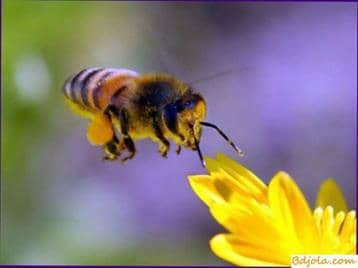Pollen toxicity of bees

Pollen toxicosis is an infectious disease of bee colonies caused by the pollen of poisonous plants.
Causes of the disease. The disease develops in young bees when feeding pollen from poisonous plants. The bee pickers bring the pollen of poisonous plants to the hive without harm to themselves, since they place it in the hamstring of the hind legs. Pollen feed mainly young bees, which are also more sensitive to poisoning.
Poisoning of young bees causes pollen of onions, wolf fighter, brisket, buttercup, blubber, rosemary, ragwort, tobacco, wolfberry, cotton, white chauffeur, black chauffeur, Daurian chamois.
Symptoms of poisoning occur in young bees after 25 minutes and not later than 5 hours. The development of the disease is also facilitated by a disturbance of the water balance. Digestion of pollen occurs when consuming a large amount of water. Water young bees receive from fresh brought nectar; in the absence of a bribe in nature, they collect it from puddles, streams, ponds, rivers. In non-flying weather (cold, rains), bees experience a big drawback in water.
With a large number of open brood bees, nurses, especially when they lack, have to consume large amounts of pollen, which leads to intestinal overflow, constipation and non-digestibility of feed. Pollen, containing poisonous substances, disrupts digestion. When exposed to toxic substances on the body of the bee, peristalsis ceases, large quantities of pollen accumulate in the middle and back colon, and the whole organism becomes intoxicated. The poisoned bees are disturbed, they crawl out of the hive with a crowded belly and die. Bees perish at the age of 3-13 days and most often at the age of 10 days.
Course of the disease. Pollen toxicosis usually occurs briefly. It often begins with the disease and the death of a small number of young bees, but in the following days the number of diseased bees grows rapidly,
Symptoms of the disease. Disease usually young working bees – bees-wet nurse, having a gray color, due to the presence of a large number of hairs on the body. Sick bees quickly crawl out of the hives, fall to the ground and die near the hive or away from it. Initially, the diseased bees are in an excited state, which is replaced by oppression. As the loss of strength, bees become more sluggish and die with convulsive twitchings. The abdomen of patients and dead bees is increased due to pollen overflow of pollen.
The diagnosis of pollen toxicity is based on clinical, pathological data and microscopy. Characteristic signs of pollen toxicity are the excitation of bees with subsequent inhibition, the extinction of young bees, the overflow of the middle and the rectum of pollen, the number of adult cells (platocytes of the V and VI stages) increases in the hemolymph of the patients of bees and the number of younger cells (platocytes of the III and IV stages) decreases.
Prevention. Given that in some localities the disease has a seasonal periodicity that coincides with the flowering of some plant species and depends on seasonal meteorological changes that occur during the year, it is necessary to regularly supply bee colonies with water or liquid 33% sugar syrup in order to prevent the disease during this period.
Control measures. The disease usually occurs briefly and quickly stops with the appearance of honey. With prolonged disease, families are fed a liquid 33% sugar syrup. Feeding is conducted in the evening after the summer of bees for 1-2 days. Sugar syrup is given in 0.5-1 liters and more, depending on the strength of the family and fodder stocks. In addition, families provide sufficient water supplies, which are given in individual watermelons.
Pollen toxicity of bees
